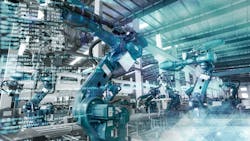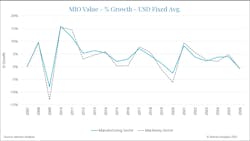Global Manufacturing Production to Reach Value of $44.5 Trillion in 2022
Market intelligence firm Interact Analysis has released new research projecting 4% growth in 2022 for total manufacturing industry output. Global manufacturing production will reach a value of $44.5 trillion. A slight decline of $0.2 trillion is expected in 2023 followed by a rise once again in 2024 and 2025.
This growth will benefit the many industries serving the manufacturing sector such as fluid power as it will likely lead to increased demand for hydraulic and pneumatic and other related products.
The National Fluid Power Association's (NFPA) most recent Fluid Power Industry Growth Trend (at time of publishing this piece) continues to show growth in component shipments. Total fluid power shipments in March 2022 were up 14.9% and industrial hydraulic shipments had increased compared to the previous month.
Manufacturing is a key industry for fluid power manufacturers, therefore growth in the manufacturing sector will help lead to further growth for hydraulics and pneumatics.
READ MORE: Fluid Power Market to Grow 7% in 2022
As the global economy began to recover in the second half of 2020 after the initial onslaught of the COVID-19 pandemic, demand for a variety of products—from consumer goods to construction equipment to personal electronics—greatly increased. While benefiting the manufacturing industry, it also presented its struggles and continues to do so as supply chains and labor markets remain strained.
The semiconductor shortage in particular remains challenging for many markets, with automotive being the most prominent due to its heavy reliance on this component.
"Automotive is particularly worthy of comment at the moment," says Adrian Lloyd, CEO at Interact Analysis, in the firm's press release announcing the release of its new manufacturing research. "The sector was already facing severe pressures following the pandemic, and the Ukraine conflict has made matters far worse for the industry. One of these problems is the new pressures on semiconductors, which already hit the automotive sector hard.
"Another is that Russia provides the majority of the world’s palladium which is used to produce catalytic converters and is now inaccessible. And yet another problem is that Ukraine is a key manufacturer of components for Western Europe’s automotive industry, particularly wire harnesses, supplies of which are now intermittent. As a result of all this, we predict minimal growth for automotive of 2.8% in 2022."
Geopolitical and Pandemic Impacts
Three months later and the conflict between Ukraine and Russia continues. As such, Interact Analysis has included profiles of the two countries in its new research as the conflict between them is impacting many sectors like manufacturing.
Although Russia has a small manufacturing base, its largest companies are energy suppliers. The ongoing conflict has lead to an increase in oil and gas prices, mostly for Europe, and therefore could impact the manufacturing industry which relies on these energy sources to operate.
Interact Analysis notes that about 30% of Ukraine's GDP (gross domestic product) comes from industrial production. The country produces 70% of the world's Neon which is a key input for semiconductors. Half of the Neon produced in Ukraine comes from Odessa and Mariupol, which are key targets for Russia; at the time of publishing this piece Mariupol has fallen to Russia, but Odessa remains under Ukrainian control.
It is anticipated the cost of Neon will rise due to the conflict, causing further struggles for semiconductor production. This could cause manufacturers to turn to cheaper suppliers in China, says Interact Analysis in its press release.
Also impacting the manufacturing industry are the various ongoing effects of the COVID-19 pandemic. Among them are the arrival of new variants which are causing case numbers to increase in parts of the world.
Shanghai is set to end the lockdown it has been under for the past two months on June 1. The lockdown was initiated due to rising COVID cases in the city; China's zero-COVID approach has lead to lockdowns throughout the pandemic as a means of mitigating spread of the virus.
Interact Analysis says this lockdown will undoubtedly impact the manufacturing industry not only because manufacturing is a large economic sector for China, but also because Shanghai is home to a port which handles over 25% of all Chinese freight traffic. If similar measures are implemented in one of China's major manufacturing hubs, the global economy could suffer as China accounts for 44.4% of total global production output, states Interact Analysis.
Reuters reported on May 24 that Beijing has stepped up quarantine efforts to help mitigate its latest COVID outbreak. Manufacturing accounts for about 20% of Beijing's GDP, so impacts to the sector may be minimal.
However, lockdowns in China are impacting economic sentiment as over 40 cities were under lockdowns as of a May 5 report from CNBC. Citing a survey from the EU Chamber of Commerce in China, almost 60% of European businesses in the country were reportedly cutting 2022 revenue projections, half of which were by 6-15%, due to COVID controls. Sentiment has also fallen among Chinese manufacturing businesses to its lowest level since the start of the pandemic.
Despite these and other challenges the manufacturing industry is facing, overall a continued high level of demand for various products from around the world will keep the sector on a positive trajectory.
About the Author
Sara Jensen
Executive Editor, Power & Motion
Sara Jensen is executive editor of Power & Motion, directing expanded coverage into the modern fluid power space, as well as mechatronic and smart technologies. She has over 15 years of publishing experience. Prior to Power & Motion she spent 11 years with a trade publication for engineers of heavy-duty equipment, the last 3 of which were as the editor and brand lead. Over the course of her time in the B2B industry, Sara has gained an extensive knowledge of various heavy-duty equipment industries — including construction, agriculture, mining and on-road trucks —along with the systems and market trends which impact them such as fluid power and electronic motion control technologies.
You can follow Sara and Power & Motion via the following social media handles:
X (formerly Twitter): @TechnlgyEditor and @PowerMotionTech
LinkedIn: @SaraJensen and @Power&Motion
Facebook: @PowerMotionTech

Leaders relevant to this article:


